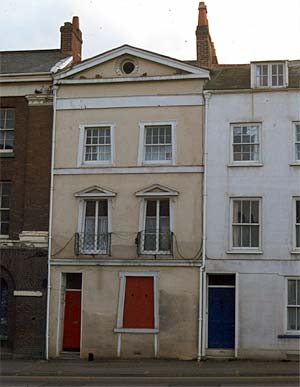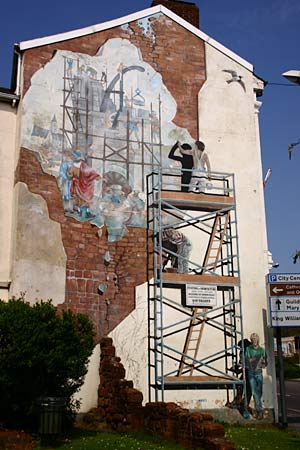
Holloway Street
Page updated 20 June 2009
 Almost
1,500 years before the first use of the name of Holloway Street, the
Romans laid out the line of the Topsham Road between their quay at
Topsham and the fortress of Exeter. Straight and flat all the way, the
Shutebrook valley was their only
concession to the topography, with a bend to descend and cross the
Shutebrook.
Almost
1,500 years before the first use of the name of Holloway Street, the
Romans laid out the line of the Topsham Road between their quay at
Topsham and the fortress of Exeter. Straight and flat all the way, the
Shutebrook valley was their only
concession to the topography, with a bend to descend and cross the
Shutebrook.
When the Western Way was bulldozed through the West Quarter and the large roundabout at the bottom of South Street created, all the buildings outside the South Gate were demolished. On the site of the Valiant Soldier on the corner of Holloway Street and Magdalen Street was found a Roman cemetery for it was normal for the Romans to establish a cemetery by the road side, just outside the city walls. Coins from the rule of three emperors were excavated and grave goods such as figurines and glassware found. The archaeologists also found a system of trenches that were dug by the Roman army to support the timbers of at least three rectangular buildings around a courtyard.
The Civil War
Fifteen hundred years later, and a hostel named the Goat existed on the site. A lease of 1623 records the name changed to the Golden Lion. An inn on this site would have offered a safe haven to travellers who were locked out of the city after the gates were closed at night. The Golden Lion was demolished in 1645, along with many other properties close to the city wall, to clear a field of view for the Royalist defenders, during the Civil War. After hostilities had ceased, the Valiant Soldier was built on the site, as Holloway Street and the Topsham Road became an important link in the export of Exeter wool, during the times when the canal was inoperative.
First referred to as Holoway in 1515, the street was previously called Cartynstrete. Formerly named Holloway Street in 1867, it is thought that the name refers to the road being worn away through constant traffic. It would certainly have been a hard pull for carters and other horse drawn vehicles and the dip in the road may have encouraged the surface to be washed away in time of rain and flood. Richard Izacke in his Antiquities of the City of Exeter recorded for the year 1617 of Holloway Street:
'A Collection of mony to bee made by & from ye Inhabitants of the Citty & suburbs towards the fillinge Vpp of Holloway wth out ye Southgate'
Which indicates that the street was steeper and deeper than it is today and the only way to get it fixed was increase the council tax! As Holloway Street climbed into the Topsham Road, it passed within 40 ft of the old Mount Radford House. In 1779, John Baring had the road moved towards the church and a cutting made to ease the hill for horse drawn traffic. An arched footbridge to link Mount Radford with the church was still in place in the 1920's.
Great Larkbeare house, the oldest building in the street, at the bottom of the valley was part of an original castellated 15th century house. Built for woollen merchants, before it was sold in 1737 to John Baring, of the Baring Bank family. The house went into decline and in 1889 it was partly demolished when Roberts Road was developed and Holloway Street widened. The remnant on the corner of Roberts Road is a reminder of an earlier city.
Victorian Holloway Street
The proximity of Trews Weir Paper Mill nearby provided work for the inhabitants of Holloway Street and William Kerslake, and his son, also William, who resided at 40 Holloway Street, were both listed as paper makers in 1851. William Johns, a bookbinder also lived in the street in the same year.
Holloway Street School was opened on 24 July 1876 for girls and infants. In 1901 it was expanded and in 1902 it became a City Council school. It closed as a Council school in July 1958 and the Roman Catholic School in the Mint occupied the premises. In 1973, the school moved to new premises at Matford Lane and the old school buildings used for various purposes until it became the Kingdom Hall of Jehovah's Witnesses.
In September 1871, a bad stench was reported from the opening into the sewer at the bottom of Holloway Street, by Great Larkbeare House. It had caused several cases of diarrhoea and the Water Company was informed. Then in February 1899 "a portion of the pavement at the bottom of Holloway-street collapsed .... It is surmised that owing to the soaked state of the ground through the late heavy rains the brickwork of a drain fell in. Fortunately no one was passing the spot at the time."
Two people from the street died in the Theatre Royal fire of 1887. Eighteen year old Henry Gange of 17 Holloway Street and 22 year old Thomas Henry Taverner who was a porter were the victims.
Fallen Girls
The Exeter Diocesan Association for the Care of Girls was founded in 1879 to help girls 'in moral danger', and those involved in 'an immoral way of life'. The headquarters was at 20 Holloway Street, where girls between 13 and 16 years old who had 'lost their character' were taught domestic duties and eventually found work, normally in service. Pregnant girls were cared for at St Olave's Home, Bartholomew Street, and fallen girls were cared for at Friars Walk.
World War One Dead - Holloway Street
Able Seaman, Cyril Edgar
Brook, H.M.S. "Brisk.", Royal Navy. 31 October 1917. Age 32.
Serjeant,
Frederick Thomas Hunt, Devonshire Regiment. 4 November 1918. Age 28.
Lansdowne Terrace.
Serjeant, Albert John Isaac,
Devonshire Regiment. 25 March 1918. Age 37.
Private,
Walter James Jeffrey, Royal Army Medical Corps. 26 December 1917.
Age 22.
Private, Percy Reynolds, Devonshire Regiment. 9
May 1917. Age 21.
Rifleman, C Landsborough, Rifle
Brigade. 19 January 1916.
Bombing Casualties
The last fatal bombing raid on Exeter, was on 30 December 1942. See Bombing Victims for more details. Those killed were:
Christopher Robert Broom,
age 2, 17 Holloway Street
Frederick John Brown, age 9, 17
Holloway Street
Francis Sarah Brown, age 69, 17 Holloway Street
John
William Dowling, age 38, 18 Holloway Street
Mary Ann Dymond, age
77 6 Holloway Buildings
Constance Alice Lewis Friendship,
Holloway Street
Betty Jeanette McGuigan, age 8 16 Holloway
Street
Brian Hugh McGuigan, age 5 16 Holloway Street
Frederick
Wallam Treuge, age 59,
Holloway Street
June Ann Vanstone, 6 months, 16 Holloway
Street,
Winifred Lilian Vanstone, age 25, 16 Holloway Street
George
Frederick Vincent, age 60,
Holloway Street
William Watson, age 54,
Holloway Street
The modern Holloway Street is still steep in places. At the city end, just before the roundabout, on Western Way, can be found the Backpackers Hostel which has on its end wall a large mural to occupy the bored driver as he waits for the lights to change.
 Looking down Holloway Street
Looking down Holloway Street This house is one of the last
near the Southgate to remain. Photo from 1983, courtesy Dick Passmore.
This house is one of the last
near the Southgate to remain. Photo from 1983, courtesy Dick Passmore. The Year of Architecture mural in
Holloway Street.
The Year of Architecture mural in
Holloway Street.
Public Houses in Holloway Street
Antelope Tavern
Artillery Arms
Black Dog
Bombardier Inn
Exmouth Inn
Valiant Soldier
Weymouth Arms
The Windmill
│ Top of Page │